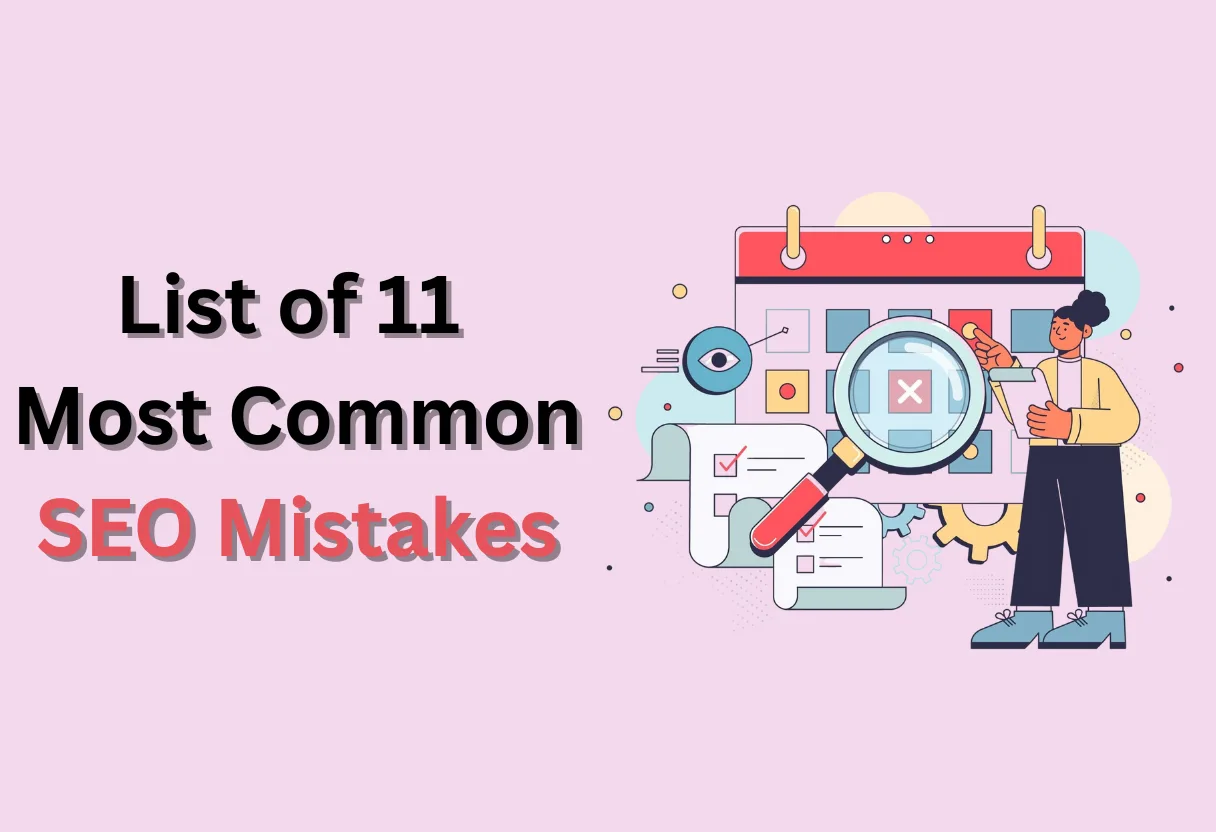Give the people what they want!! An easy peasy line in the SEO world, but harder to deliver. As it is all about the details.
On the upside, if done correctly it would reap results. The downside is you can say goodbye to your business making global footprints if not done properly.
So here are the 11 mistakes which will give an insight into the do’s and don’ts, if you are just starting. If you are a pro, it changes algorithms too quickly that it keeps you on your toes.
According to 99 signals, Google made 13 algorithm updates in 2021. To rank higher and outsmart the updates you constantly have to apply optimization techniques. This list will help you with that. To get more of a preview, you can take a look at the below pictures which gives an insight into mistakes done in SEO.


So, read on for avoiding these mistakes.
11 Most Common SEO Mistakes and How to Avoid Them
1) Poor on-page optimization
When we say there is poor on-page optimization on the website, we mean:
- Low Content quality
- Low Keyword density
- Confusing title and description
- Improper URLs structure
- Bad Page experience and usability
- Inept Media optimization
- Shady Internal and external links, etc.
Above are prime mistakes that should be avoided like plague. If mistakes are prevalent, it sends a wrong message to users. Ultimately snapping off any connection between users and marketers.
As a website is a medium through which connection can be made strong and generates trust. But you can correct this. How?
Tip: run an SEO audit and check any mistakes in landing pages like titles, descriptions, keyword density, etc.
2) Not using keywords correctly
Keywords are crucial in SEO as they direct users to your site and help bring in organic traffic. Now the facts,
Only ten searches per month or less are made for 92.42 percent of terms.
You can imagine the gravity of the situation if keywords are not used correctly. These happen when there is
- Placing keywords in an improper manner
- Stuffing of keywords in titles
- Not done enough keyword research.
Any one of the above scenarios can be detrimental to your online business. Let’s see how –
- Placement of keywords – keywords are stuffed just for the sake. Either they don’t have any relevance or if they are relevant then also one or two high-ranking keywords are only used. In the end, it looks spammy and creates a bad user experience.
- Stuffing keywords in titles – At one time, stuffing titles with keywords used to make you rank, but not anymore.
Write titles that are relevant to your content. Also, titles with more than 50 to 60 characters get shortened.
- Not doing keyword research – A lot of people are under the impression that if you create blogs or keywords which they like, they will rank higher.
As they are thinking along the lines of common users. They can’t be more wrong!!
There is no simple way to say this – You must master keyword research if you want to rank higher in search results.
3) Improper title tags and metadata
According to Ahrefs, 25.02 percent of pages with high rankings lack a meta description.
Metadata and title tags serve as the web page’s name tags. Your browser tab shows the title, which identifies the website or webpage you are viewing.
One of the key factors for ranking in SERPs is metadata. Now, imagine if these web pages don’t have meta tags, then how can they remain in the top spot in SERPs?
As it is crawled by search engines when looking for optimization or ranking the site. But, due to this many individuals cater to the metadata content for search engine sites. This should not be the case.
Mistakes in your meta title may detract from your website’s performance in search results or mislead visitors. What to avoid then?
- Not attempt to create a page title
- Long title length
- Using the same name for your page as your domain or business name
- Using the same name or a variation of it for all of your pages
- Naming the webpage without tying it to your content or any other metadata (like the meta description)
- Keyword repetition in the title
4)Inaccurate content
You must provide content that is in line with search intent( user intent) if you want your pages to rank on Google.
According to 99 signals, User intent is so crucial that Google’s Quality Raters Guidelines mention it 333 times (QRG).
But many times marketers fail in cracking user intent. Why?
The problem is that you rank for a particular keyword and fail to notice that the topic of content is something else itself.
This error frequently happens because of:
- Attempting to cover several themes in one piece of information
- The practice of producing shoddy work merely to include keywords
- Use several keywords in a single piece
Your main objective should be to create content that addresses the queries and requirements of your target audience, taking into account the use of appropriate search phrases.
With content, marketeer can make two grave mistakes:
- They are not delivering the right content to the right audience
- Not creating content on E-A-T theory which is Expertise, Authoritative, and Trustworthiness
Creating content that is according to Google’s guidelines will only help in ranking higher.
5) Duplicate or low-quality images
Concerning on-page SEO problems, duplicate or low-quality image issues are one the common errors made.
There are times when the image component of your website renders poorly because the filename, file location, or extension was incorrect. In this case, an alt tag for images will work wonders.
It will describe its contents and functions on the page. It also helps crawlers to identify keywords, when desired keywords are reinforced.
6) Focusing on the wrong keywords
Anyone would think that, if you have the correct SEO strategy then it would have the correct keywords. You can’t be more wrong!!
Not having the right keywords is a common phenomenon that every other marketer experiences. This can happen when
- You are targeting broad keywords that already have larger competition
- Global keywords, when your services are restricted in the local arena
- Generic keywords, which attract visitors but not a prospective customer
Tip: Try to be more specific. In the world of digital marketing, it doesn’t hurt to be more specific.
For example, if anyone is having graphic designing as a business.
Then having keywords as graphic design may not give you as many results as ‘graphic designing for e-commerce websites in Seattle‘ will give you.
7) Not adjusting your website to different devices
Mobile devices account for 52.2% of all website traffic worldwide.
So, you can imagine why having a mobile-friendly website is a must.
SEO is not only about optimizing content but giving an overall experience to the users. Google can trace the user experience of the site and thus can lower your ranking in SERPs.
So don’t feel disappointed when you fall lower in SERPs when your website is having-
- A non-friendly mobile site
- Slow site speeds
- Block files
- Slow to load images and videos
- Interstitials ads
- Poor local information
- Non-responsive web design
The above parameters are judged by Google to give you a ranking. So it would be wise if you can act upon the tips listed below.
Tip:
- Improve the site’s load time
- Ensure that designs are mobile friendly and can be accessed anywhere
- Ensure that mobile content gives better user experience.
8) Ignoring the Competition
Any good athlete will study their competitor’s game and learn their strategy and try to implement it. SEO works around the same lines.
Predict your competitors’ next move and beat them at their own game.
Instead of competing against their real SEO rivals, many SEO experts are compelled to work under the business’s presumptions about who they are competing with for organic search traffic.
Rather they should know who their competitors are in the digital world. Also, how their products and services are better than ours, and what are they implementing in their SEO strategy?
This can be done by following the below steps:
- Discover actual SEO competitors
- Rule out the competitors who are not the competition
- Identifying the star product/powerhouse content in the Competitors’ sites
- Study your Competitor’s site and get an insight on what they are focussing upon
- Choose foundational keywords which will give an edge to your SEO strategy
- Identify keyword gaps
- Widen your keyword horizons.
9) Not Using Enough Internal Links
66.31% of pages have little to no backlinks.
In general, a page receives more Google organic traffic the more backlinks it has.
Internal links help Google in indexing and understand your web page better. If implemented strategically, then Internal links can send Page authority ( Page Rank) to important pages.
In short: Internal linking is a key to ranking on Google.
You can tell Google which pages on your site are crucial and what they are about by providing it with links to follow along with informative anchor text.
The best part of this method is that it only requires you to create one internal link, and each new backlink you acquire for your linkable asset will gradually and consistently improve your converting page.
Just keep in mind that internal links still require meaningful content. Your internal link needs to make sense within the context of the page on which it is located.
10) Improper site architecture
When Google indexes a website, it factors human behavior into account. How much time is spent on the website, and how many pages are visited on the website?
Google takes in everything to determine SERP rankings. Therefore disregarding UX and website structure should be a big no-no for any marketer.
To design an SEO-friendly website including site structures and UX design. So how can you correct the website if there is an improper site structure?
- Use clean and short URLs
- Make navigation simple and user friendly
- Don’t use excessive CTAs or pop-up ads
- Avoid layout shifts
- Optimize on-page structure
- The data is not structured well
Simplifying these optimization factors will help your traffic grow in leaps and bounds.
11) Not Having a Proper SEO Strategy
This one has to be the worst mistake anyone can make. There is a proverb,
If you fail to plan, you plan to fail.
There is no point in optimizing all the above points if you don’t have any strategy in place. Surprisingly, this is one aspect that almost every organization be it a big enterprise or small business lacks.
According to SEJ, last year alone, 36% of small businesses had an SEO strategy.
However many plans fail, as building a sustainable strategy requires multiple stakeholders like – website, PR content, product, IT, and engineering.
Also, there is a factor of any executive but-in or having improper knowledge of SEO. But if you don’t have a strategy in place, it is time to have one.
Tip: Prepare a plan which will understand your competition, make a plan on content administered in the site and look for technologies which can help you in the workflow.
With these, we have come to the end of the blog. But not end it without FAQs for the marketer who is just starting out in the digital marketing world.
Frequently Asked Questions
1) – What are the consequences of making these mistakes?
You will lose the credibility of your site and product or worse, it will rank on the bottom page of Google SERPs.
2) – What can you do if you’ve already made one of these mistakes?
Part from correcting the mistakes, you can also study the above blog where we have mentioned potential fixes to the mistakes made in SEO strategy.
3) How can you avoid making these mistakes in the first place?
By employing an SEO team who knows the ropes of the business and can guide your business to new heights.
4) What effect does site speed have on SEO?
Page load speed is one of the key factors to rank in SERPs. Slow websites discourage visitors. Fast sites provide a better user experience, and Google will rank them higher.
5) – How does UX affect your SEO?
UX has a powerful impact on SEO. Due to its consideration of elements like page speed, mobile responsiveness, menu/header layout, and URL structure, it aids in user engagement. These factors help in getting an understanding of the preferences of users.
The blog wants to make the point that SEO is an indispensable tool for any marketer. The mistakes listed above can be made by anyone, be they pro or a novice. So it is important to know the in and outs of SEO and upgrade your skills.







